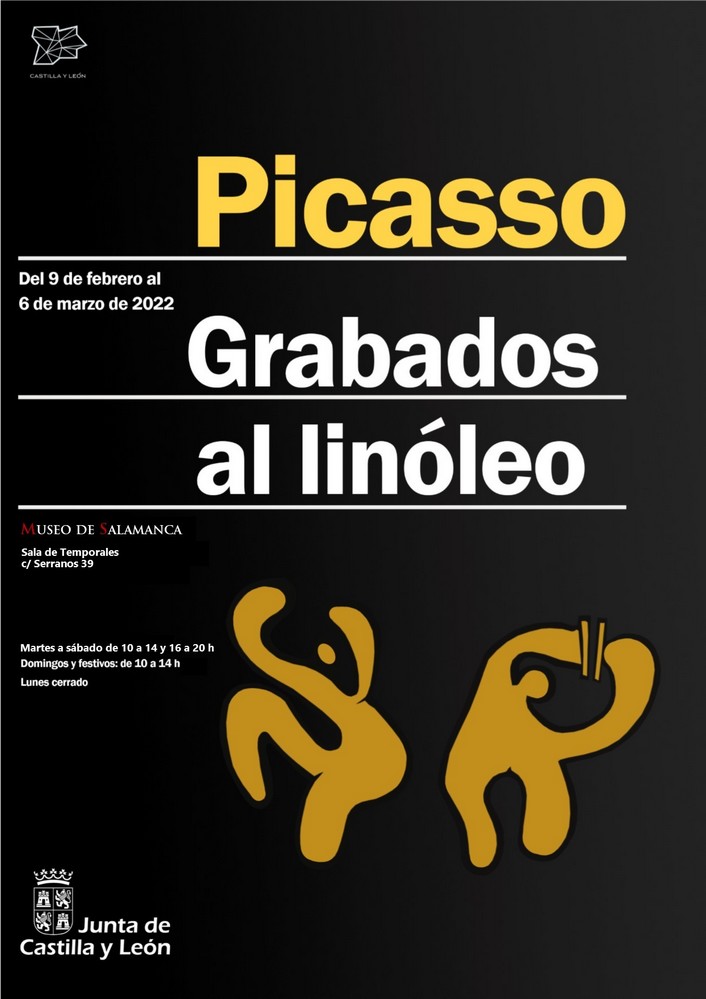

Web en desarrollo. Abierto de martes a domingo: 10 a 14h. De martes a sábado: 16 a 20h. Lunes cerrado.
museo.salamanca.deac@jcyl.es – 923 21 22 35

El Museo de Salamanca. En los años 50’ el linograbado se convierte en una de las técnicas favoritas de Pablo Picasso y colabora con el impresor Hidalgo Arnéra.
En el linograbado una matriz de linóleo ( fabricado con linaza y otros elementos naturales como el serrín, yute u otro) se utiliza para crear el grafismo en relieve. Una vez generada la imagen se entinta y mediante un tórculo se genera la copia en el papel.
Picasso desarrolló intuitivamente técnicas que agotaron las posibilidades ofrecidas por el nuevo medio. Al hacer algunos grabados, se dice que Picasso utilizó instrumentos de zapatero, cuchillos etc., para que la superficie quedara más tosca y tuviese esa calidad textural.
Los temas que aborda los temas recurrentes de su universo: retratos femeninos, escenas de mujeres, tauromaquia, bacanales, …
La primera edición de esta serie consta de una tirada de cincuenta ejemplares que se expusieron en galería Louise Leiris de París: «Picasso 45 gravures sur linoleum 1958-1960» y dos años después, se procede a una nueva tirada esta vez de 520 ejemplares. El alemán Wilhem Boeck, historiador de arte, comenta en la introducción que escribió para esta serie, editada por Verlag Gerd Hatje, Sttutgart y Éditions Cercle d’Art (París en 1962):

| Cookie | Duración | Descripción |
|---|---|---|
| cookielawinfo-checkbox-advertisement | 1 year | Set by the GDPR Cookie Consent plugin, this cookie is used to record the user consent for the cookies in the "Advertisement" category . |
| cookielawinfo-checkbox-analytics | 11 months | This cookie is set by GDPR Cookie Consent plugin. The cookie is used to store the user consent for the cookies in the category "Analytics". |
| cookielawinfo-checkbox-functional | 11 months | The cookie is set by GDPR cookie consent to record the user consent for the cookies in the category "Functional". |
| cookielawinfo-checkbox-necessary | 11 months | This cookie is set by GDPR Cookie Consent plugin. The cookies is used to store the user consent for the cookies in the category "Necessary". |
| cookielawinfo-checkbox-others | 11 months | This cookie is set by GDPR Cookie Consent plugin. The cookie is used to store the user consent for the cookies in the category "Other. |
| cookielawinfo-checkbox-performance | 11 months | This cookie is set by GDPR Cookie Consent plugin. The cookie is used to store the user consent for the cookies in the category "Performance". |
| CookieLawInfoConsent | 1 year | Records the default button state of the corresponding category & the status of CCPA. It works only in coordination with the primary cookie. |
| elementor | never | This cookie is used by the website's WordPress theme. It allows the website owner to implement or change the website's content in real-time. |
| viewed_cookie_policy | 11 months | The cookie is set by the GDPR Cookie Consent plugin and is used to store whether or not user has consented to the use of cookies. It does not store any personal data. |
| Cookie | Duración | Descripción |
|---|---|---|
| _ga | 2 years | The _ga cookie, installed by Google Analytics, calculates visitor, session and campaign data and also keeps track of site usage for the site's analytics report. The cookie stores information anonymously and assigns a randomly generated number to recognize unique visitors. |
| _ga_2B6TQ3B5LZ | 2 years | This cookie is installed by Google Analytics. |